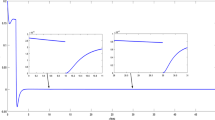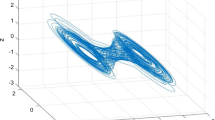Abstract
This paper is concerned with networked \(L_2\)-gain control for a T-S fuzzy system over an event-triggered communication network. Taking an event-triggered communication scheme and network-induced delays into consideration, the networked control system is described by an asynchronous T-S fuzzy system with an interval time-varying delay. Due to variation characteristic of network-induced delays, the interval is decomposed into N subintervals and the jumping among these subintervals is governed by a Markov chain. A new relaxation method, which fully utilizes the convexity of normalized membership functions and the deviation bounds of asynchronous normalized membership functions, is proposed and a stochastic Lyapunov–Krasovskii functional is constructed to derive some delay-dependent criteria on \(L_2\)-gain performance analysis and controller design of the asynchronous T-S fuzzy system. An illustrative example is provided to show that the proposed criteria are of less conservatism and less computational complexity than some existing results, and are effective in achieving a prescribed \(L_2\)-gain performance.



Similar content being viewed by others
References
Gupta, R.A., Chow, M.Y.: Networked control system: overview and research trends. IEEE Trans. Ind. Electron. 57(7), 2527–2535 (2010)
Napoles, J., Watson, A.J., Padilla, J.J., Leon, J.I., Franquelo, L.G., Wheeler, P.W., Aguirre, M.A.: Selective harmonic mitigation technique for cascaded h-bridge converters with nonequal dc link voltages. IEEE Trans. Ind. Electron. 60(5), 1963–1971 (2013)
Romero-Cadaval, E., Spagnuolo, G., Franquelo, L.G., Ramos-Paja, C.A., Suntio, T., Xiao, W.M.: Grid-connected photovoltaic generation plants components and operation. IEEE Ind. Electron. Mag. 7(3), 6–20 (2013)
Zhang, W., Branicky, M.S., Phillips, S.M.: Stability of networked control systems. IEEE Control Syst. Mag. 21(1), 84–99 (2001)
Zhang, L., Gao, H., Kaynak, O.: Network-induced constraints in networked control systems—a survey. IEEE Trans. Ind. Inf. 9(1), 403–416 (2013)
Wang, T., Gao, H., Qiu, J.: A combined adaptive neural network and nonlinear model predictive control for multirate networked industrial process control. IEEE Trans. Neural Netw. Learn. Syst. (2015). doi:10.1109/TNNLS.2015.2411671
Zhang, D., Han, Q.L., Jia, X.: Network-based static output feedback tracking control for a class of systems using the positive effects of network-induced delays. In: American Control Conference (ACC), pp. 5676–5681 (2012)
Zhang, D., Han, Q.L., Jia, X.: Network-based output tracking control for a class of T-S fuzzy systems that can not be stabilized by nondelayed output feedback controllers. IEEE Trans. Cybern. 45(8), 1511–1524 (2015)
Yang, F., Zhang, H., Hui, G., Wang, S.: Mode-independent fuzzy fault-tolerant variable sampling stabilization of nonlinear networked systems with both time-varying and random delays. Fuzzy Sets Syst. 207, 45–63 (2012)
Yue, D., Han, Q.L., Lam, J.: Network-based robust \(H_\infty\) control of systems with uncertainty. Automatica 41(6), 999–1007 (2005)
Gao, H., Chen, T., Lam, J.: A new delay system approach to network-based control. Automatica 44(1), 39–52 (2008)
Huang, D., Nguang, S.K.: State feedback control of uncertain networked control systems with random time delays. IEEE Trans. Autom. Control 53(3), 829–834 (2008)
Zhang, L., Shi, Y., Chen, T., Huang, B.: A new method for stabilization of networked control systems with random delays. IEEE Trans. Autom. Control 50(8), 1177–1181 (2005)
Peng, C., Yang, T.C.: Communication-delay-distribution-dependent networked control for a class of T-S fuzzy systems. IEEE Trans. Fuzzy Syst. 18(2), 326–335 (2010)
Li, H., Yu, J., Hilton, C., Liu, H.: Adaptive sliding-mode control for nonlinear active suspension vehicle systems using T-S fuzzy approach. IEEE Trans. Ind. Electron. 60(8), 3328–3338 (2013)
Chiu, C.S., Li, Z., Chen, Y.: T-S fuzzy direct maximum power point tracking of wind energy conversion systems. Int. J. Fuzzy Syst. 15(2), 192–202 (2013)
Yu, G.R., You, C.S.: Nonlinear robust control of fuzzy time-delay systems. Int. J. Fuzzy Syst. 11(1), 29–35 (2009)
Jiang, X.: On sampled-data fuzzy control design approach for T-S model-based fuzzy systems by using discretization approach. Inf. Sci. 296, 307–314 (2015)
Jiang, X., Han, Q.L.: On designing fuzzy controllers for a class of nonlinear networked control systems. IEEE Trans. Fuzzy Syst. 16(4), 1050–1060 (2008)
Wang, Y., Zhang, H., Zhang, J., Wang, Y.: An sos-based observer design for discrete-time polynomial fuzzy systems. Int. J. Fuzzy Syst. 17(1), 94–104 (2015)
Boldbaatar, E.A., Lin, C.M.: Self-learning fuzzy sliding-mode control for a water bath temperature control system. Int. J. Fuzzy Syst. 17(1), 31–38 (2015)
Tong, S.C., Li, Y.M., Feng, G., Li, T.S.: Observer-based adaptive fuzzy backstepping dynamic surface control for a class of MIMO nonlinear systems. IEEE Trans. Syst. Man Cybern. Part B 41(4), 1124–1135 (2011)
Tong, S.C., Sui, S., Li, Y.M.: Fuzzy adaptive output feedback control of MIMO nonlinear systems with partial tracking errors constrained. IEEE Trans. Fuzzy Syst. 23(4), 729–742 (2015)
Li, Y.M., Tong, S.C., Li, T.S.: Observer-based adaptive fuzzy tracking control of MIMO stochastic nonlinear systems with unknown control directions and unknown dead zones. IEEE Trans. Fuzzy Syst. 23(4), 1228–1241 (2015)
Li, H., Sun, X., Wu, L., Lam, H.K.: State and output feedback control of a class of fuzzy systems with mismatched membership functions. IEEE Trans. Fuzzy Syst. (2015). doi:10.1109/TFUZZ.2014.2387876
Li, H., Wu, C., Yin, S., Lam, H.K.: Observer-based fuzzy control for nonlinear networked systems under unmeasurable premise variables. IEEE Trans. Fuzzy Syst. (2015). doi:10.1109/TFUZZ.2015.2505331
Li, H., Gao, Y., Shi, P., Lam, H.K.: Observer-based fault detection for nonlinear systems with sensor fault and limited communication capacity. IEEE Trans. Autom. Control (2015). doi:10.1109/TAC.2015.2503566
Li, H., Wu, C., Shi, P., Gao, Y.: Control of nonlinear networked systems with packet dropouts: interval type-2 fuzzy model-based approach. IEEE Trans. Cybern. (2014). doi:10.1109/TCYB.2014.2371814
Li, H., Gao, Y., Wu, L., Lam, H.K.: Fault detection for T-S fuzzy time-delay systems: delta operator and input-output methods. IEEE Trans. Cybern. 45(2), 229–241 (2015)
Jia, X., Zhang, D., Hao, X., Zheng, N.: Fuzzy \(H_{\infty }\) tracking control for nonlinear networked control systems in T-S fuzzy model. IEEE Trans. Syst. Man Cybern. Part B 39(4), 1073–1079 (2009)
Jia, X., Chi, X., Han, Q.L., Zheng, N.: Event-triggered fuzzy \(H_{\infty }\) control for a class of nonlinear networked control systems using the deviation bounds of asynchronous normalized membership functions. Inf. Sci. 259, 100–117 (2014)
Zhang, D., Han, Q.L., Jia, X.: Network-based output tracking control for T-S fuzzy systems using an event-triggered communication scheme. Fuzzy Sets Syst. 273(15), 26–48 (2015)
Peng, C., Yue, D., Fei, M.: Relaxed stability and stabilization conditions of networked fuzzy control systems subject to asynchronous grades of membership. IEEE Trans. Fuzzy Syst. 22(5), 1101–1112 (2014)
Zhang, X.M., Han, Q.L.: Network-based \({\text{ H }}_{\infty }\) filtering using a logic jumping-like trigger. Automatica 49(5), 1428–1435 (2013)
Hespanha, J.P., Naghshtabrizi, P., Xu, Y.: A survey of recent results in networked control systems. Proc. IEEE 95(1), 138–162 (2007)
Xiong, J., Lam, J.: Stabilization of linear systems over networks with bounded packet loss. Automatica 43(1), 80–87 (2007)
Zhang, X., Han, Q.L.: Novel delay-derivative-dependent stability criteria using new bounding techniques. Int. J. Robust Nonlinear Control 23(13), 1419–1432 (2013)
Peng, C., Fei, M.R.: An improved result on the stability of uncertain T-S fuzzy systems with interval time-varying delay. Fuzzy Sets Syst. 212(1), 97–109 (2013)
Han, Q.L.: Improved stability criteria and controller design for linear neutral systems. Automatica 45(8), 1948–1952 (2009)
Acknowledgments
This work was supported in part by the Natural Science Foundation of China under Grant Nos. 61403240, 61374059, and 61573230, and the Research Project supported by Shanxi Scholarship Council of China (2015-016).
Author information
Authors and Affiliations
Corresponding author
Appendices
Appendix 1: Proof of Theorem 1
For the system (11), define a new process \(\{(x_t,r(t)),\ t\!\ge \!0\}\) by \(\{x_t(s)\!=\!x(t+s),\ -\tau (t,r(t))\!\le \! s\!\le \!0\}\). Now we construct a stochastic Lyapunov–Krasovskii functional (LKF)
where
\(P\!>\!0, Q_i\!>\!0,R_i\!>\!0\) , and \(W_i\!>\!0 \ (i\!=\!1,2)\), \(s_k\!=\!i_k^lh\!+\!\tau _{t_k+l}\), and \(x_t\!=\!x(t\!+\!\theta ), \ \theta \!\in \![-\tau _M,0]\) is an element of Banach space \({\mathcal {C}}([-\tau _M,0],R^n)\) of continuous functions from \([-\tau _M,0]\) to \(R^n\).
First, \(W_1,W_2\)-dependent terms in the LKF (26) are discontinuous at updating instants \(\{i_k^lh\!+\!\tau _{t_k+l}\}_{k=0, l=0}^{\infty ,N_k},\) and they are non-negative just before \(i_k^lh\!+\!\tau _{t_k+l}\) and become zero just after \(i_k^lh\!+\!\tau _{t_k+l}\); the other terms are continuous, i.e., \(\lim _{t\rightarrow (i_k^lh+\tau _{t_k+l})^{-}}V_4(x_t,r(t),t)\!\ge \!0\) and \(\lim _{t\rightarrow (i_k^lh+\tau _{t_k+l})^{+}}V_4(x_t,r(t),t)\!=\!0\). This implies \(V(s_k^+)\!\le \!V(s_k^-)\).
Second, we prove the stochastic stability for the system (11) with \(\omega (t)=0\). Let \({\mathcal {L}}\) be the weak infinitesimal generator of \(\{(x_t,r(t)),t\ge 0\}\), then for \(r(t)=p\in {\mathcal {I}}\), we have
For \(r(t)\!=\!p\), \(t\!\in \!\Omega _{l,k}\), \(\tau (t,p)\) satisfies \(\tau _m\!+\!(p\!-\!1)\sigma \!\le \!\tau (t,p)\!\le \!\tau _m\!+\!p\sigma\) and \(\sum _{q=1}^N\lambda _{pq}=0\). Then we have
For any appropriately dimensioned matrices \(M_1\) and \(M_2\), the following equality is true:
One can use Lemmas 1 and 2 to obtain that
where \(\xi (t)\!=\![x^T(t)\ \ x^T(t\!-\!\tau _m)\ \ x^T(t\!-\!\tau (t,p))\ \ e_k^T(t\!-\!\tau (t,p))\ \ x^T(t\!-\!\tau _M)\ \ x^T(s_k)\ \ \dot{x}^T(t)]^T\). Then for \(t\!\in \!\Omega _{l,k}\), we have
where \(\Pi _{ij}^0(t)\!=\!\Pi _{ij}^1(t)\!+\!\Pi _{ij}^2(t)\!+\!\Pi _{ij}^0\!+\!\tau _mE_1^TR_2^{-1}E_1\), \(\Pi _{ij}^1(t)\!=\!(\tau _M\!-\!\tau (t,p))\Pi\), \(\Pi _{ij}^2(t)\!=\!(\tau (t,p)\!-\!\tau _m)\sigma \sum _{q=1}^Nq\lambda _{pq}E_2^TW_2^{-1}E_2\). It can be seen from the inequality (12) that
By using the S-Procedure technique, one can see that for all non-zero \(\xi (t)\) satisfying (30), the inequality \(\sum _{i=1}^r\sum _{j=1}^r\mu _i\mu _j^k\xi ^T(t)\Pi _{ij}^0(t)\xi (t)\!<\!0\) is equivalent to the existence of a scalar \(\tilde{\delta }>0\) such that
If (31) holds, then the system (11) with \(\omega (t)\!=\!0\) is stochastically stable.
Notice that \(\Pi _{ij}^0(t)\) is a convex combination of \(\Pi _{ij}^1(t)\) and \(\Pi _{ij}^2(t)\) on \(\tau (t,p)\), using the convex combination technique and Schur complement, the inequality (31) holds if the following inequalities are satisfied:
Using the proposed relaxation method in Remark 3 and Lemma 3, if the LMIs (13)–(17) are satisfied, for \(v\!=\!1,2\), we have \(\sum _{i=1}^r\sum _{j=1}^r\mu _i\mu _j^k\Psi _{ij}^v\!<\!0\). It is easy to see that there exists a scalar \(\alpha \!>\!0\), such that
Applying Dynkin’s formula, we can obtain
which implies that the closed-loop system (11) with \(\omega (t)\!=\!0\) is stochastically stable.
Last, under the zero initial condition, we consider \(L_2\)-gain for the system (11) with \(\omega (t)\!\ne \!0\). Employing the LKF (26), we have
where \(\tilde{\Pi }_{ij}^0(t)\!=\!\Pi _{ij}^0(t)\!+\!e_1^TC_i^TC_ie_1\).
Using the convex combination technique and Schur complement, we have that
holds if the following inequalities are satisfied:
Using the introduced free-weighting \(H_i^v\) and the method mentioned in Remark 3, if the conditions (13)–(17) are satisfied, for \(v=1,2\), we have
which implies \({\mathcal {L}}V<-z^T(t)z(t)+\gamma ^2\omega ^T(t)\omega (t)\) for the system (11) with the constraint (12).
For \(t\!\in \!\Omega _{l,k}\), it follows from (34) that
since V(t) is non-increasing and positive definite in \([0,\infty )\), then under the zero initial condition, it is easy to obtain that \({\mathcal {E}}\left\{ \int _0^\infty z^T(s)z(s){\mathrm{d}}s\right\} \!\le \!\gamma ^2\int _0^\infty \omega ^T(s)\omega (s){\mathrm{d}}s\). Therefore, the closed-loop system (11) is stochastically stable with \(\gamma\)-disturbance attenuation. This completes the proof.
Appendix 2: Proof of Theorem 2
Define \(M\!=\!M_1^{-1}\!=\!\beta M_2^{-1}, \ \bar{P}\!=\!M^TPM, \ \bar{S}\!=\!M^TSM,\ \bar{Q}_i\!=\!M^TQ_iM, \ \bar{R}_i\!=\!M^TR_iM, \ \bar{W}_i\!=\!M^TW_iM\ (i\!=\!1,2), \ \bar{E}_i\!=\!M^TE_iM\ (i\!=\!1,2), \Delta \!=\) diag\(\{ M,M,M,M,M,M,M \}\), \(\bar{H}_{i^1}\!\!=\) diag \(\{ \Delta ^T, I,M^T\}\) \(H_i^1\) diag \(\{ \Delta ,I,M \},\) \(\bar{H}_i^2=\) diag \(\{ \Delta ^T,I,M^T,M^T \}\) \(H_i^2\) diag \(\{ \Delta ,I,M,M \}\ (i\!=\!1,2,\ldots ,r)\) , and \(Y_j\!=\!K_jM(j\!=\!1,2,\ldots ,r)\). Then, pre- and postmultiply diag\(\{M,M\}^T\) and its transpose to (13), diag\(\{\Delta ^T,I,M^T\}\) and its transpose to (14)–(17) for \(v\!=\!1\), diag\(\{\Delta ^T, I, M^T,M^T\}\) and its transpose to (14)–(17) for \(v\!=\!2\), respectively. Using the Schur complement, one can readily arrive at (18)–(22) from (13)–(17). This completes the proof.
Rights and permissions
About this article
Cite this article
Jia, X., Zhao, J. & Zhang, D. L 2-Gain Control for T-S Fuzzy Systems Over an Event-Triggered Communication Network Using Delay Decomposition and Deviation Bounds of Membership Functions. Int. J. Fuzzy Syst. 18, 817–828 (2016). https://doi.org/10.1007/s40815-015-0127-z
Received:
Revised:
Accepted:
Published:
Issue Date:
DOI: https://doi.org/10.1007/s40815-015-0127-z




